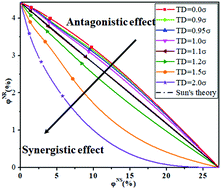Synergistic effect in improving the electrical conductivity in polymer nanocomposites by mixing spherical and rod-shaped fillers†
Abstract
In this work, coarse-grained molecular dynamics simulation is adopted to investigate the effect of hybrid fillers [nanospheres (NSs) and nanorods (NRs)] on the conductive probability of polymer nanocomposites (PNCs) in the quiescent state and under the shear field. The percolation threshold gradually rises as the volume fraction ratio (α) of NSs to all the fillers increases in the quiescent state. Compared to the NSs, the greater number of beads in the NRs help them connect to other NRs to form the conductive network. Meanwhile, compared to NSs, more NRs participate in building the conductive network. A transition from the synergistic effect to the antagonistic effect occurs as the NS–NR tunneling distance is reduced. Furthermore, the shear field induces a more direct aggregation structure of NSs, which act as linkers between fillers to protect the conductive network. This result is confirmed by the fact that more NSs occupy the conductive network under the shear field. As a result, the percolation threshold declines with increasing shear rate. Finally, compared to in the quiescent state, the percolation threshold increases at α = 0.0 and remains nearly unchanged for α = 0.25 under the shear field, while it gradually decreases for α ≥ 0.5. In total, the results further our understanding of how to realize the synergistic effect between NSs and NRs when forming a conductive network of PNCs.



 Please wait while we load your content...
Please wait while we load your content...